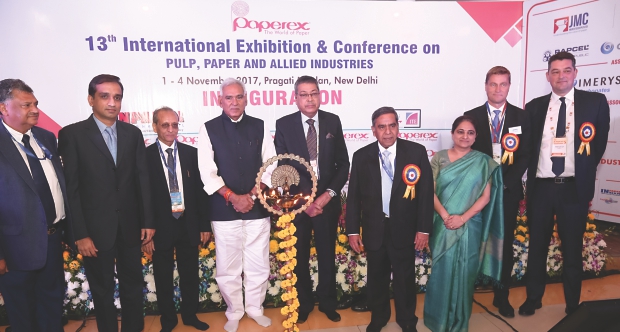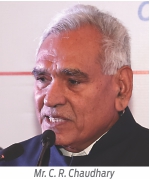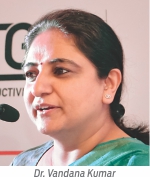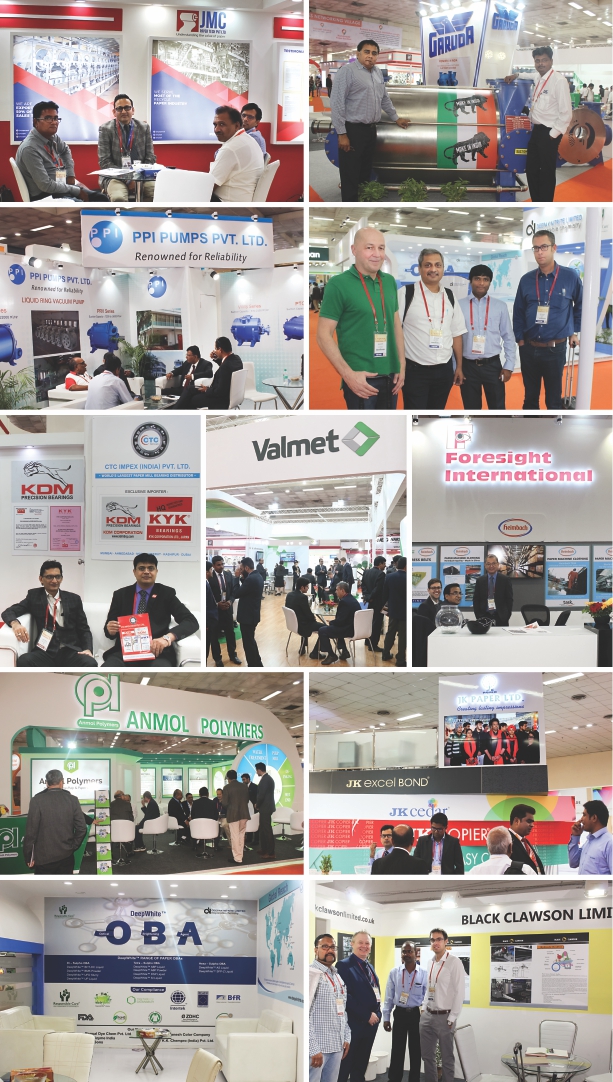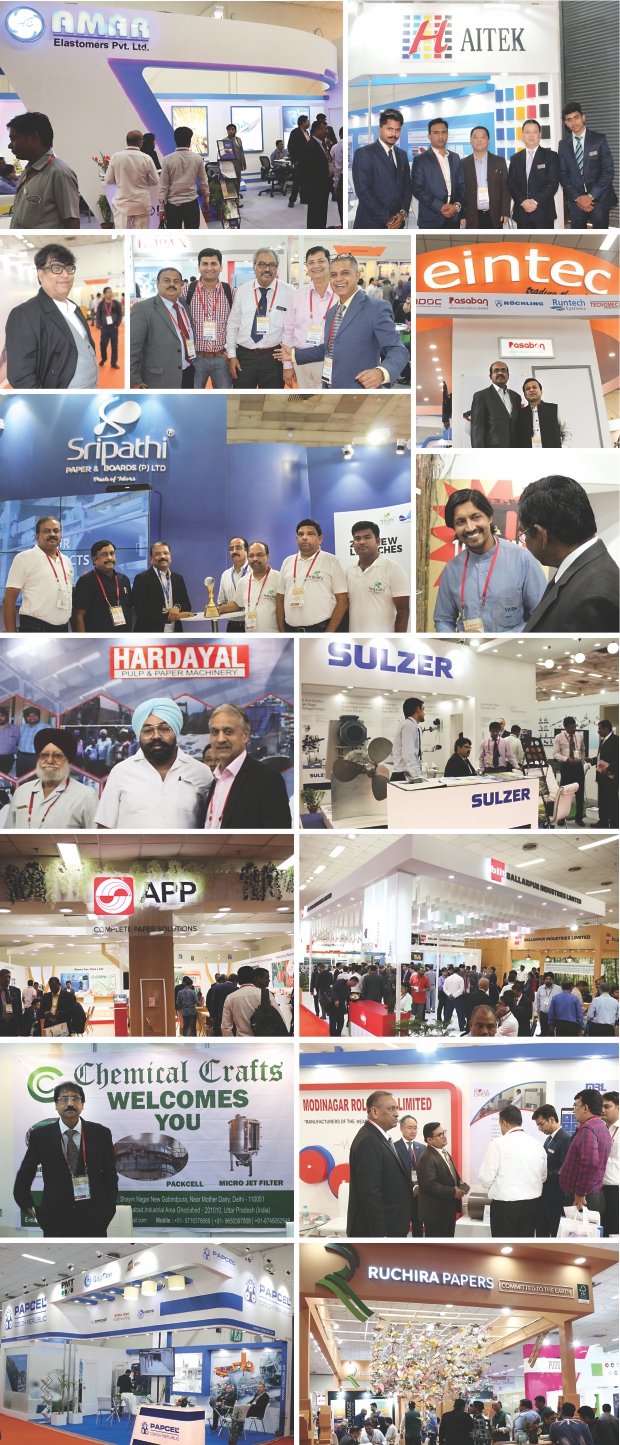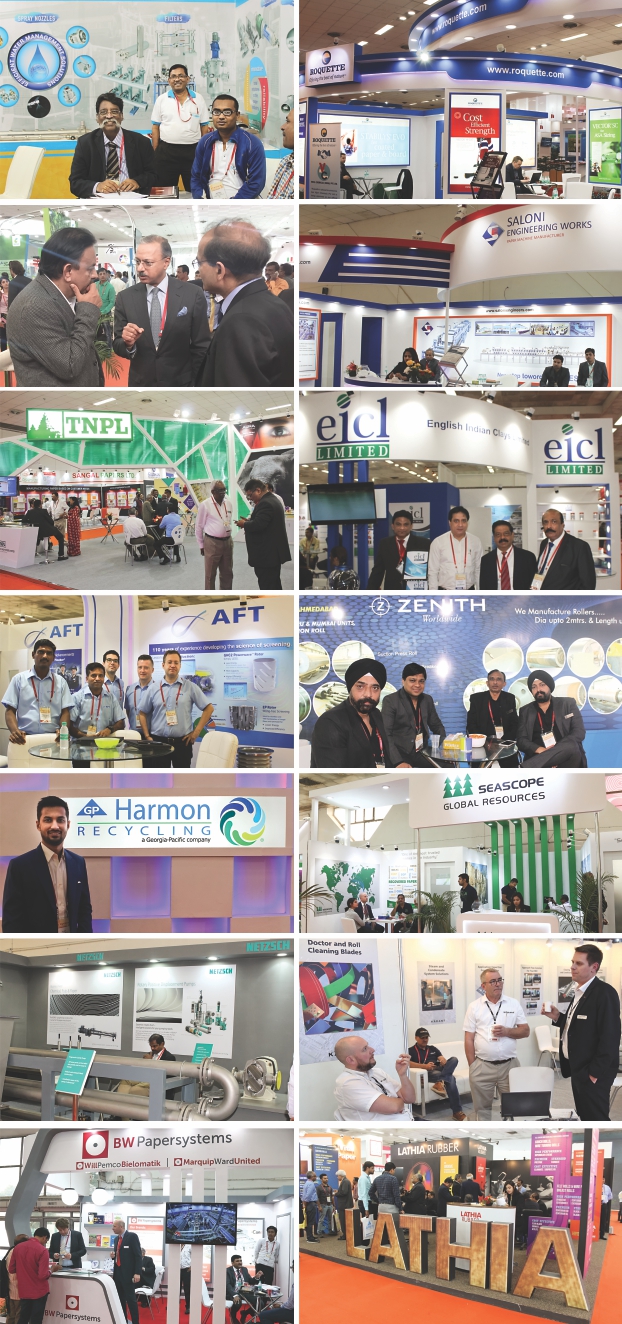The inaugural session of Paperex 2017 saw some serious deliberation on the key issues of the industry including plight of the newsprint industry, threatening levels of import of paper and board, efforts in environmental compliance, technology’s role in operational optimization, etc. The celebration of the first World Paper Day became the highlight of this edition among other things.
The 13th edition of Paperex, held from November 1-4, 2017 at Pragati Maidan, New Delhi, proved to be a major success yet again with participation of 568 leading exhibitors from 30 countries and 23,794 trade visitors from 59 countries. Paperex 2017 was inaugurated by Mr. C. R. Choudhary, Hon’ble Minister of State for Commerce and Industry, Government of India amid much fanfare and in presence of many eminent faces of the industry. Dr. Vandana Kumar, Joint Secretary, Department of Industrial Policy & Promotion was also present at the occasion as the Guest of Honor.
Being the biggest show of the Indian paper industry, Paperex attracted all top brands to display their products at the show. Companies such as BILT, JK Paper, Century, International Paper, Trident, TNPL, West Cost, Pudumjee, APP, Valmet, Voith, Andritz and others were conspicuous by their presence and highly attractive stall designs. The show like before also became the venue for various new launches and the leading exhibitors unveiled new products and special offers for their customers.
Simultaneously with the show, there were conferences and technical sessions with various significant themes that the paper industry urgently needs to discuss. The conference on “Pulp and Paper Industry: Strategies for Sustainable Growth” by IARPMA, Executive Committee Meeting of Indian Paper Manu-facturers Association (IPMA) and Indian Pulp and Paper Technical Association, Celebration of Paper Day by Federation of paper Traders associations of India (FPTA), Paper Industry Meet by CAPEXIL, etc. were some of the important events to attend to. Besides, Various Business Networking & Information Lounges (BNILs) were also set up by major trade bodies of the paper industry.
However, the major highlight of the occasion this year was the celebration of first World Paper Day on November 1, to be observed subsequently each year on the same date. A pledge was taken that every person should buy a piece of paper on this today to show solidarity with this very beautiful and sustainable industry.
.
Wise Use of Agro-based Raw material
Speaking on the occasion, Hon’ble Minister Mr. C. R. Chaudhary first congratulated the organisers to put together such a huge and important show for the paper industry. The minister said that import of 15-20 percent of paper indicates that consumption is growing in India and the domestic industry should try to match the demands through its own production. He however also added that the consumption is much below the world average and it needs to grow in times to come and the industry should be ready to meet the demands generated out of this growth as there would be immense requirement of capital and technology. “Only 1 kg increase in per capita consumption at present level entails at least a million tonne capacity requirement asking for huge investments,” the minister said.
Mr. Chaudhary also applauded the fact that the paper industry is one of the largest employers in India. He however also added that the industry is marred by various challenges which need to be addressed on immediate basis. “The raw material shortage and growing environmental pressure are two challenges which are interrelated and compound each other,” he said.
The minister was of the opinion that the industry can address the issue of raw material by optimizing recycling by maximizing the recovery of wastepaper, which is still far lower than the world’s average. “Agro-residue like wheat straw and bagasse should not be wasted and burnt. And, we can better use bagasse for papermaking than burning it to produce energy as is done in sugar mills. Environmentally, it’s not the best use of bagasse as resource,” said the minister.
Mr. C. R. Chaudhary also said that the industry needs to upgrade its technology from time to time, and it must not use the obsolete technology, which is bad for both quality and environment apart from keeping you from competing with the best. He also urged the industry to take all necessary measures to keep its employees and take advantage of the Govt.’s schemes like Pradhanmantri Kaushal Vikas Youjna.
On the issue of imports and providing the industry with level playing field with its competitors, Mr. Chaudhary said, “The industry must pursue the matter through all channels and represent the Govt. duly on the issue. I am sure that Govt. will take due cognizance of the issue and redress it in time.”
.
Young India Needs Huge Amount of Paper
“Paper is perhaps one of the most significant inventions of the mankind and it has a very-very special place in our country,” said Dr. Vandana Kumar, the Guest of Honour. “We are a young nation and we have decided that every citizen of this country should have access to education. This in itself is a living proof of how important paper is for us.”
“When we think of adorning each soul of India with a pen, we also have to think of providing them with a text book and a notebook,” said Dr. Kumar. “Added to that, we are the fast growing economy with a burgeoning consumer base, a condition which indicates ample growth of each paper segment, especially the packaging board. These factors would keep driving the paper demand, and we are in a strong and happy space as far as demand growth is concerned.”
“As noted, the paper is not growing as much in the developed part of the world as it’s growing in India. Yes, we do have some constraints on supply and demand side, but with the kind of robustness the Indian paper industry exhibit with its 800 odd mills and Rs. 56000 Cr (Rs. 560 Bn), we are sure we would surge ahead with great aplomb,” said Dr. Kumar.
Dr. Kumar was also quick to mention that the paper industry’s work on environment compliances of late is praiseworthy. “I am happy to note that the industry is becoming more and more environment focussed. The industry is cognizant of criticality of water as a resource and is focussing on a host of reduction strategies in consumption, discharge, and pollution load in effluents,” she said.
“As long as we are focussed on these strategies, we would hopefully be able to replicate the successes as in Kashipur belt. As and when the national framework comes in force, the industry would, in 3-5 years time, be able to get rid of its red tag and become an absolutely green industry,” concluded Dr. Kumar.
.
Excessive Import, a Cause to Near Collapse of News-print Industry
Speaking on the status of the Indian newsprint industry, Mr. P.S. Patwari President, Indian Newsprint Manu-facturers Association (INMA); Vice President, Eastern Region, IARPMA; and CEO & Executive Director,
Emami Paper Mills Ltd. outlined the sorry state of the newsprint industry in India, which is worsening day by day. Citing loopholes in India’s import policy, Mr. Patwari said, “Nearly half of the country’s over 100 newspaper mills have either stopped production or have become NPAs, while the rest function at 40 percent of their potential capacity, meaning 60 percent capacity remain unutilized.”
Mr. Patwari presented the grim picture of newsprint manufacturing landscape in India by saying that nearly 65 percent of the total demand is being met through imports. Warning about closure of domestic newsprint mills as a serious threat, Mr. Patwari said, “Newsprint is currently imported at under price which is significantly less than both the selling cost within exporting countries and the cost of production in Indian mills, even after including the freight cost.”
Urging immediate government action to curb imports, Mr. Patwari said, “Unless some corrective measures are taken, the import bill with regards to newsprint will keep on rising rapidly and the time is not distant when it will double from the current USD 800 million.”
Mr. Patwari further said, “The Govt. should think of levying at least 10 percent duty on such imports, which was earlier there. Allowing cheap imports any further would surly prove detrimental to the survival of the newsprint industry India. It will not only cause revenue losses, but the closure will also result in taking away employment of thousands.”
“We assure the Govt. that we are capable of fulfilling the vision of ‘Make in India’ provided we are allowed to operate in a level playing field,” said Mr. Patwari.
.
Increasing Imports, a Serious Threat to Existing Investments
Resting his address on the status of Indian paper industry, Mr. Saurabh Bangur, President, Indian Paper Manufacturers Association (IPMA) & Managing Director, The West Coast Paper Mills Ltd. said, “The Indian paper industry has taken rapid strides in the last decade to raise its production and quality levels to meet growing demands in the country. The industry has the resilience to face all sorts of challenges and work towards gaining comparative advantage on sustained basis by conserving re-sources, reducing costs, and improving efficiency and quality at all levels.”
Mr. Bangur also suggested that the growth of the Indian paper industry is visible when its counterparts in developed regions are complaining of growth saturations and that India represents an island of growth amid growth aridity elsewhere. He said that the paper industry is growing with same rate as that of the nation’s GDP and will keep growing with the rate in times to come. “Modern lifestyle and paper consumption are synonymous. All developed regions have 5-8 times more per capita consumptions of paper, suggesting that India has lots of potential to grow,” he said.
“Besides traditional domain of W&P, the industry is innovative in providing effective solutions for growing e-commerce and packaging. Expanding middle class, rise in personal disposable income, exposure to international standards, etc. are leading to lifestyle changes, providing fillip to paper consumption,” said Mr. Bangur.
Talking about challenges, Mr. Bangur also raised the issue of growing imports hampering the growth of the industry in true sense, “When the industry is already grappling with the issue of producing paper and board at competitive, the problem gets more compounded by the Govt.’s policy of extending preferential tariff treatment to imports under existing FTAs. Substantial quantity of paper is being imported into the country at significant lower cost under FTAs. What is alarming is that the imports are growing at a higher rate than the domestic production growth rate.”
Speaking further on the issue, Mr. Bangur said, “The Pulp & Paper Industry has made substantial investments in the last 5 years and it is becoming very difficult to meet its financial obligation in view of significant drop in margins. 2/3rd paper mills have already been closed and if no urgent steps are taken, it is feared that some more mills may face closure, impacting the employment of many.
“As things stand today, there is a very serious threat of existing investments in capacities turning economically unviable. Given this state of affairs vis-à-vis existing investments, it is quite likely that industry will be discouraged from further investments in capacities – which are necessary to meet the expected growth in domestic demand for paper and paperboard. The inevitable consequence of a fall in investments will be a multiplier adverse impact on the Indian farmer community with whom the industry has strong linkages and a significant outflow of foreign exchange towards increased imports of paper and paperboard. This will be against the Hon’ble Prime Minister’s initiative of ‘Make in India’.”
Mr. Bangur also took up the issue of negative public notion about the industry that it is destroying natural resources. He apprised the audience that IPMA is taking slew of measures to allay this myth and make people aware of the fact that paper is one of the most environmentally sustainable products available there and that the industry plants more trees than it harvests. “The industry has been engaging in social and farm forestry on degraded lands for wood sourcing and planting more trees than we are cutting. So, we are wood positive,” he said.
.
Technology, Process Optimization & Automation: New Buzzwords
Paperex this time invited Mr. Kari Tuominen, President and CEO, ANDRITZ Oy, Finland for the keynote address cum S.V. Memorial Lecture. He said, “For ANDRITZ, India is very important market, and ANDRITZ’s Chennai branch has become the integral part of our global activity. Much of the key engineering, quality control, and startup services for all our boilers around the world today are handled from Chennai. For certain product groups, the Chennai office is a fundamental part of our excellent operations worldwide. During these years, the activities have been expanded into other product areas gradually.”
On the developments taking place in the global pulp and paper industry, Mr. Tuominen said, “If we talk about the growth of the paper industry globally, it is around 8 million tonnes per year, of which India is contribution around 1 million tonne a year, which is very significant.” He further said that to satisfy such big capacity growth, fiber has to come from somewhere and that’s the reason why several big size pulp mills, some as big as 1.95 million tonnes of annual capacity, are being developed and started up.
Mr. Tuominen also said that besides big capacity set-ups, tremendous amount of emphasis is being put also in R&D to improve operations. “The main goal of such R&D is to develop sustainable and customized technology suited to specific regional requirements and environmental compliance. Such efforts can yield desirable outcome only with close cooperation with clients, with other suppliers, and various research institutions and universities,” he remarked.
Energy efficiency is one of the most significant areas, where the western world is focused at, Mr. Tuominen said. “One the one hand, power requirement of pulp mills has been steadily decreasing in the western region, on the other, power generation has been increasing. And, today, all the pulp mills, be it hard wood or soft wood, are producing whole lot of excess power. This has been achieved by effective modern machinery, new screen type, new refiners, new washing equipment, and so forth.”
Emphasizing the integration of mill-wide systems to optimize operations, Mr. Tuominen said, “You can’t think of a fiber line as a stand-alone department any longer in terms of energy efficiency. You need to combine that with evaporation operations, and so forth and make sure that you are not wasting any of energy that is generated. You need to preserve every bit of energy and turn it into saleable power.”
Mr. Touminen also added that besides energy efficiency, material consumption must also be lowered by paying attention on how to optimize the wood handling operations. He emphasized on the need of efficient water-cycles in the mills and how to reutilize the treated effluents in a number of ways.
“India is the 5th largest producer of the paper and board and 12th biggest producer of pulp in the world. We also see that the demand of industrial grade is growing fast. Considering the prospect, the paper and board consumption in India would be somewhere around 24 million tonnes. However, in order to be competitive in future, the Indian paper industry needs to keep certain things in kind, viz. the best use of raw material, especially the non-wood based, investment in right technology, the use of IIoT, modern de-inking plants, solid waste handling, mill-wide integration, and so forth,” said Mr. Tuominen.


